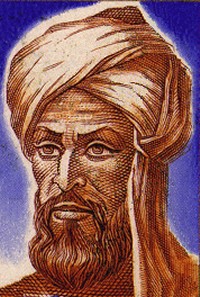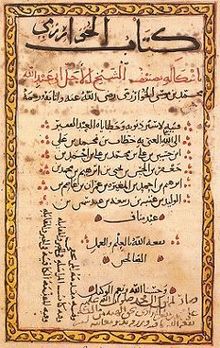
Muhammad ibn Musa al-Khwarizmi was a Persian Shi'a Muslim mathematician, astronomer, astrologer and geographer. He was born in Persia of that time around 780 and he died around 850. We have a little true knowledge about the life of Muhammad ibn Musa al-Khwarizmi. Historians have different interpretations on his life and the origin of his name al-Khwarizmi.
On that time, Harun al-Rashid became the fifth Caliph of the Abbasid dynasty in 786. He ruled from his court, in the capital city of Baghdad, over the Islamic empire which stretched from the Mediterranean to India. He brought culture to his court and tried to establish intellectual disciplines, which at that time were not flourishing. Harun died in 809.
There was an armed conflict between his two sons al-Amin and al-Mamun. Al Mamun finally became Caliph and ruled the empire from Baghdad. He continued the patronage of learning and founded an academy called “the House of Wisdom” where Greek philosophical and scientific works were translated. He built up a library of manuscripts, the first major library to be set up since that of Alezandria, collecting important works from Bysantium.
Al-Khwarizmi was scholar in the House of Wisdom in Baghdad. His task was the translation of Greek scientific manuscripts. He also studied and wrote many books and treatises.
His Algebra was the first book on the systematic solution of linear and quadratic equations.
Consequently Al-Khwarizmi is to be considered to be the father of algebra, a title he shares with Diophantus. Latin translations of his Arithmetic, on the Indian numerals, introduced the decimal positional number system to the Western world in the 12th century. He revised and updated Ptolemy's Geography as well as writing several works on astronomy and astrology.
His contributions not only made a great impact on mathematics, but on language as well. The word algebra is derived from al-jabr, one of the two operations used to solve quadratic equations, as described in his book. The words algorism and algorithm stem from algoritmi, the Latinization of his name. His name is also the origin of the Spanish word guarismo and of the Portuguese word algarismo, both meaning digit.
Contributions
His major contributions to mathematics, astronomy, astrology, geography and cartography provided foundations for later and even more widespread innovation in algebra, trigonometry, and his other areas of interest. His systematic and logical approach to solving linear and quadratic equations gave shape to the discipline of algebra, a word that is derived from the name of his 830 book on the subject, al-Kitab al-mukhtasar fi hisab al-jabr wa'l-muqabala or: "The Compendious Book on Calculation by Completion and Balancing". The book was first translated into Latin in the twelfth century.
His book On the Calculation with Hindu Numerals written about 825, was principally responsible for the diffusion of the Indian system of numeration in the Middle-East and then Europe. This book also translated into Latin in the twelfth century, as Algoritmi de numero Indorum. From the name of the author, rendered in Latin as algoritmi, originated the term algorithm. Some of his contributions were based on earlier Persian and Babylonian Astronomy, Indian numbers, and Greek sources.
Al-Khwarizmi systematized and corrected Ptolemy's data in geography as regards to Africa and the Middle east. Another major book was his Kitab surat al-ard("The Image of the Earth"; translated as Geography), which presented the coordinates of localities in the known world based, ultimately, on those in the Geography of Ptolemy but with improved values for the length of the Mediterranean Sea and the location of cities in Asia and Africa.
He also assisted in the construction of a world map for the caliph al-Ma'mun and participated in a project to determine the circumference of the Earth, supervising the work of 70 geographers to create the map of the then "known world".
When his work was copied and transferred to Europe through Latin translations, it had a profound impact on the advancement of basic mathematics in Europe.
He also wrote on mechanical devices like the astrolabe and sundial.

"The frontispiece of Frederic Rosen's The Algebra of Mohammed ben Musa (1831)"
Algebra
al-Kitab al-mukhtaṣar fi hisab al-jabr wa-l-muqabala “The Compendious Book on Calculation by Completion and Balancing”) is a mathematical book written approximately 830 CE. The word algebra is derived from the name of one of the basic operations with equations (al-jabr) described in this book. The book was translated in Latin as Liber algebrae et almucabala by Robert of Chester (Segovia, 1145) hence "algebra", and also by Gerard of Cremona. A unique Arabic copy is kept at Oxford and was translated in 1831 by F. Rosen. A Latin translation is kept is Cambridge.
Al-Khwarizmi's method of solving linear and quadratic equations worked by first reducing the equation to one of six standard forms (where b and c are positive integers)
squares equal roots (ax² = bx)
squares equal number (ax² = c)
roots equal number (bx = c)
squares and roots equal number (ax² + bx = c)
squares and number equal roots (ax² + c = bx)
roots and number equal squares (bx + c = ax²)
by dividing out the coefficient of the square and using the two operations al-gabr and al-muqabala ("balancing"). Al-gabr is the process of removing negative units, roots and squares from the equation by adding the same quantity to each side. For example, x² = 40x - 4x² is reduced to 5x² = 40x. Al-muqabala is the process of bringing quantities of the same type to the same side of the equation. For example, x²+14 = x+5 is reduced to x²+9 = x.
Several authors have published texts under the name of Kitab al-gabr wa-l-muqabala, including Abu Hanifa al-Dinawari, Abu Kamil (Rasala fi al-gabr wa-al-muqabala), Abu Muhammad al-Adli,
Abu Yusuf al-Missisi, Ibn Turk, Sind ibn Ali, Sahl ibn Bisr (author uncertain), and Sarafaddin al-Tusi.
Arithmetic
Al-Khwarizmi's second major work was on the subject of arithmetic, which survived in a Latin translation but was lost in the original Arabic. The translation was most likely done in the 12th century by Adelard of Bath, who had also translated the astronomical tables in 1126.
The Latin manuscripts are untitled, but are commonly referred to by the first two words with which they start: Dixit algorizmi ("So said al-Khwarizmi"), or Algoritmi de numero Indorum ("al-Khwarizmi on the Hindu Art of Reckoning"), a name given to the work by Baldassarre Boncompagni in 1857. The original Arabic title was possibly Kitab al-Jam wa-l-tafriq bi-hisab al-Hind ("The Book of Addition and Subtraction According to the Hindu Calculation").
Geography
Al-Khwarizmi's third major work is his Kitab surat al-Ard "Book on the appearance of the Earth" or "The image of the Earth" translated as Geography), which was finished in 833. It is a revised and completed version of Ptolemy's Geography, consisting of a list of 2402 coordinates of cities and other geographical features following a general introduction.
There is only one surviving copy of Kitab surat al-Ard, which is kept at the Strasbourg University Library. A Latin translation is kept at the Biblioteca Nacional de España in Madrid. The complete title translates as Book of the appearance of the Earth, with its cities, mountains, seas, all the islands and rivers, written by Abu Ja'far Muhammad ibn Musa al-Khwarizmi, according to the geographical treatise
written by Ptolemy the Claudian. The book opens with the list of latitudes and longitudes, in order of "weather zones", that is to say in blocks of latitudes and, in each weather zone, by order of longitude.
As Paul Gallez points out, this excellent system allows us to deduce many latitudes and longitudes where the only document in our possession is in such a bad condition as to make it practically illegible.
Neither the Arabic copy nor the Latin translation include the map of the world itself, however Hubert Daunicht was able to reconstruct the missing map from the list of coordinates. Daunicht read the latitudes and longitudes of the coastal points in the manuscript, or deduced them from the context where they were not legible. He transferred the points onto graph paper and connected them with straight lines, obtaining an approximation of the coastline as it was on the original map. He then does the same for the rivers and towns.
Astronomy
Al-Khwarizmi's Zij al-sindhind (astronomical tables) is a work consisting of approximately 37 chapters on calendrical and astronomical calculations and 116 tables with calendrical, astronomical and astrological data, as well as a table of sine values. This is one of many Arabic zijes based on the Indian astronomicalmethods known as the sindhind. The original Arabic version (written c. 820) is lost, but a version by the Spanish astronomer Maslama al-Majriti (c. 1000) has survived in a Latin translation, presumably by Adelard of Bath (January 26, 1126). The four surviving manuscripts of the Latin translation are kept at the Bibliothèque publique (Chartres), the Bibliothèque Mazarine (Paris), the Bibliotheca Nacional (Madrid) and the Bodleian Library (Oxford).
Jewish calendar
Al-Khwarizmi wrote several other works including a treatise on the Hebrew calendar (Risala fi istikhraj tarikh al-yahud "Extraction of the Jewish Era"). It describes the 19-year intercalation cycle, the rules for determining on what day of the week the first day of the month Tishri shall fall; calculates the interval between the Jewish era (creation of Adam) and the Seleucid era; and gives rules for determining the mean longitude of the sun and the moon using the Jewish calendar. Similar material is found in the works of al-Biruni and Maimonides.
Other works.
Several Arabic manuscripts in Berlin, Istanbul, Taschkent, Cairo and Paris contain further material that surely or with some probability comes from al-Khwarizmi. The Istanbul manuscript contains a paper on sundials, which is mentioned in the Fihirst. Other papers, such as one on the determination of the direction of Mecca, are on the spherical astronomy. Two texts deserve special interest on the morning width (Marifat saat al-mashriq fi kull balad) and the determination of the azimuth from a height (Marifat al-samt min qibal al-irtifa). He also wrote two books on using and constructing astrolabes.
Ibn al-Nadim in his Kitab al-Fihrist (an index of Arabic books) also mentions Kitab ar-Rukama(t) (the book on sundials) and Kitab al-Tarikh (the book of history) but the two have been lost.
We have already discussed the varying views of the importance of al-Khwarizmi's algebra which was his most important contribution to mathematics. Let us end this brief biography of al-Khwarizmi with a quote by Mohammad Kahn,
In the foremost rank of mathematicians of all time stands Al-Khwarizmi. He composed the oldest works on arithmetic and algebra. They were the principal source of mathematical knowledge for centuries to come in the East and the West. The work on arithmetic first introduced the Hindu numbers to Europe, as the very name algorism signifies; and the work on algebra ... gave the name to this important branch of mathematics in the European world...
Reference
Toomer, Hogendijk, Oaks , Berggren, Hogendijk, Struik, Gandz , Donald E. Knuth, Springer-Verlag. Toomer, Encyclopedia Britannica. M. Dunlop. Mactutor-Hanasi, L. C. Karpinski. Ruska, Berggren, MacTutor, Daunicht, Kennedy, Neugebauer, Wikipedia, The Free Encyclopedia, JJ O'Connor and EF Robertson, A A al'Daffa,